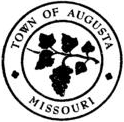Augusta History by Anita M. Mallinckrodt, PHD
In the early 1700s trappers and hunters, following river waterways and overland trails, began arriving in the area we now call Missouri. It was under French rule then, and a first settlement was St. Genevieve in 1735. In 1764, soon after the area came under Spanish ownership, St. Louis was founded. And five years later, in 1769, a Spanish military outpost was established where St. Charles would arise. It was in this period that Daniel Boone moved from Kentucky to Missouri, settling in what became Femme Osage Township. Old records refer to the famous hunter and frontiersman as the township’s “first American”.
In 1800 the area of Missouri reverted back to French rule. Thus it was part of the huge territorial acquisition, the Louisiana Purchase, which President Thomas Jefferson negotiated with France in 1803. The area was largely unsettled. Old records say that when the Missouri Territory was organized in 1821, there were only around 20,000 people within the new borders. The same year some 3500 folks living around St. Charles organized themselves into a country.
It was also 1821 when Leonard Harold, probably a Boone follower, bought the land that would become Augusta. In 1821, then, Missouri was admitted to the union as the 24th state, with slavery permitted. Not surprisingly, more explorers and settlers began arriving. In 1824, for instance, a German lawyer, Gottfried Duden, came to study unpopulated areas. After several years around where Dutzow now is located, Duden returned to Germany and published his travel report in 1829. In it he very enthusiastically encouraged emigration to Missouri’s open areas. Thus Duden motivated countless adventurous Germans, especially from Hesse and Prussia, to head for the American West.
By 1831 the first Duden-inspired German were coming up the river to the Augusta area. Many bought land close to the river to clear and farm. Others set up businesses on the bluffs overlooking the river, near Leonard Harold’s property. With increasing numbers of people arriving, Harold then laid out the town on his land in 1836 and registered it with the courts as Mt. Pleasant.
By the 1840s the German immigration wave was underway, and the settlement on the Missouri riverfront began to change. Because there was another Mt. Pleasant in the state, Missouri’s Legislature said Harold’s town had to change its name. Why “Augusta” was chosen is not clear. By the mid-1800s the people felt they need to incorporate their town and have a board of trustees to manage the growing affairs of their river-related businesses and settlement. Thus, on March 1, 1855, Augusta’s Act of Incorporation was carefully recorded onto page one of the big leather-bound ledger which has been preserved. The minutes of that first Board of Trustees meeting, and all that followed in the next half-century, are a fascinating history. Recorded from the beginning in English, the minutes at first were in the German writing style of the first settlers and after the 1870s in copybook English penmanship. Usually written with enduring ink, the minutes trace decades of Augusta’s development. First there was the rather raw riverfront settlement, with law and order problems, on the one hand, and a high level of culture among the German immigrants, on the other hand. The number and nature of the town’s small businesses were astonishing, along with the very active pro-Union participation of Augustans in the Civil War.
Next came the river’s gradual abandonment of the Augusta waterfront in the 1870s and the relocation of businesses up on the hills. There a busy trading center developed, serving the surrounding grape-growing and farming area. By the 1880s-90s Augusta was a confident small town. It had built a town hall and “calaboose”, enjoyed rail connections, anticipated telephone service, licensed road shows and granted its Base Ball Club permission to play on the Public Square.
That first half-century of Augusta’s history reflects yesteryears typical of the American Heartland and especially the German-settled regions of the Middle West. It is an appreciated past, proudly shared with those who also appreciate.
National Register of Historic Places:
Districts
Agricultural (Centennial Farm)
Architectural (Walnut St.)
Viticultural (Mt. Pleasant)
Individual Sites
Farris House (5517 High St.)
Gerling House (245 Lower St.)
Harmonie-Verein Hall (335 Hackman Rd.)
Mindrup Store/Saloon (5543 Water St.)
Schroer House/Limberg Hotel (252 Lower St.)
Sehrt House (275 Webster St.)
Staudinger/Grumke Inn (5505 Locust St.)
